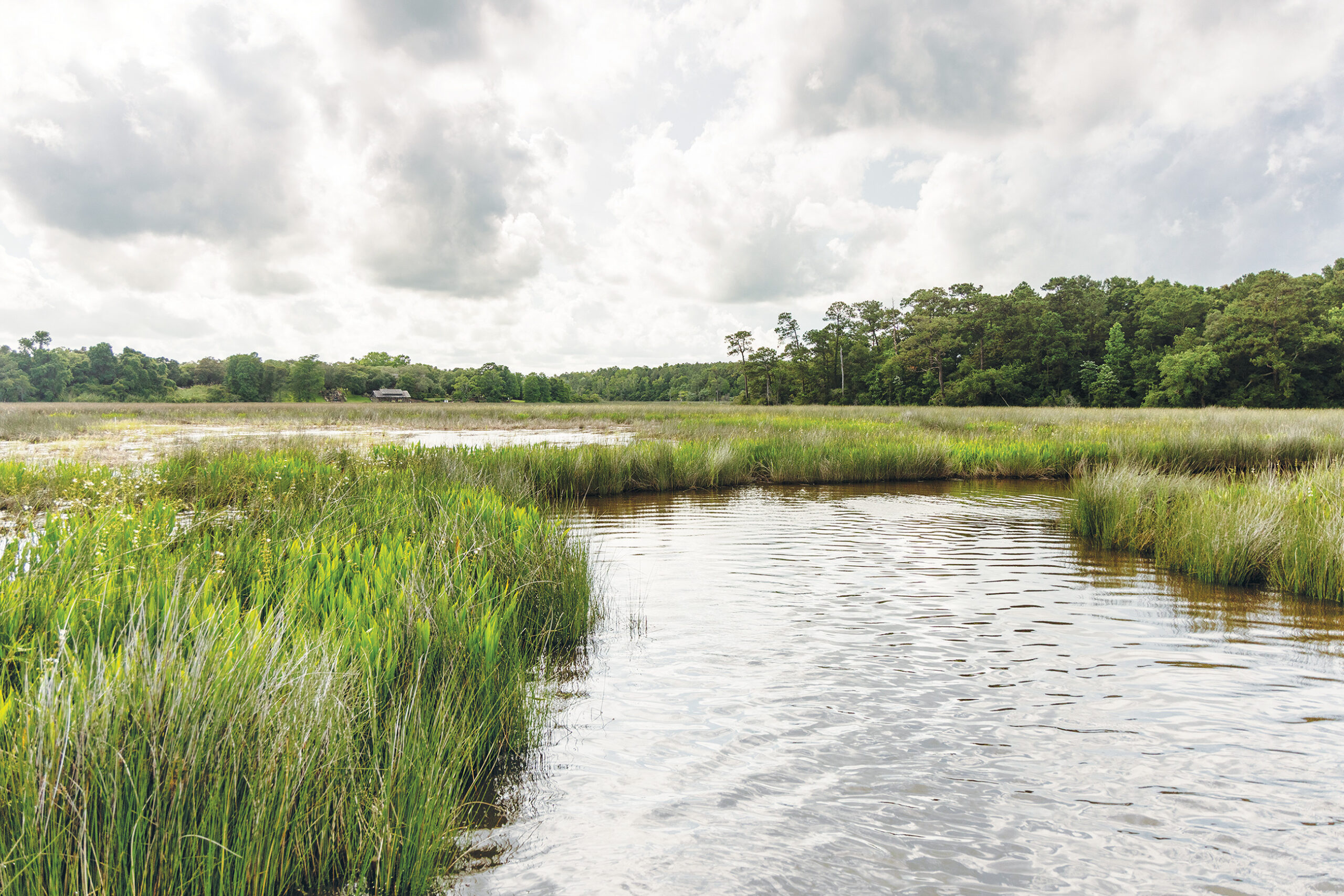
Worlds meet on Fowl River. Brackish tides flow into Mobile Bay and the Mississippi Sound, cleaving the freshwater tributaries from the briny open waters of the Gulf. Oaks, cypresses and swamp magnolias of the hardwood wetlands converge with the grass beds on the spits and in the salt marshes. Turtles amble between river and bank, and herons and ospreys breach the plane between the sky and the waves for their prey. Largemouth bass swim over flounder. Manatees drift beneath wood duck rafts. Sand settles with sediment. Men bargain with nature.
Even the people that live along the river hail from distinct, intersecting domains. Easterners have created an aquatic neighborhood of sorts, spending hours on their piers hoping friends will pull their boat over for a visit and cruising to find company when it doesn’t come to them. Dogs have their sea legs, people consider beaches extensions of their lawns and the neighborhood watch is more so on the lookout for alligators than it is for outlaws. The west is wilder — quieter. Expanses of grass beds are dappled with houses, boatyards and seafood vendors that sell to boaters from their wharf. Homes are built along the tree line, leaving the marshes undeveloped save for piers with long walkways that leave the grass flats undisturbed. Each hemisphere is differently and equally striking, balanced and precious.
The river’s kingdoms are united in their reverence for it. The purifying watershed feeds, harbors and safeguards its manifold inhabitants. Humans were long preceded by the flora and fauna that settled there, but they’ve learned their place among nature and have become stewards of its most vulnerable elements. Fowl River is home to many, and the people fortunate enough to live there know their charge to preserve it.
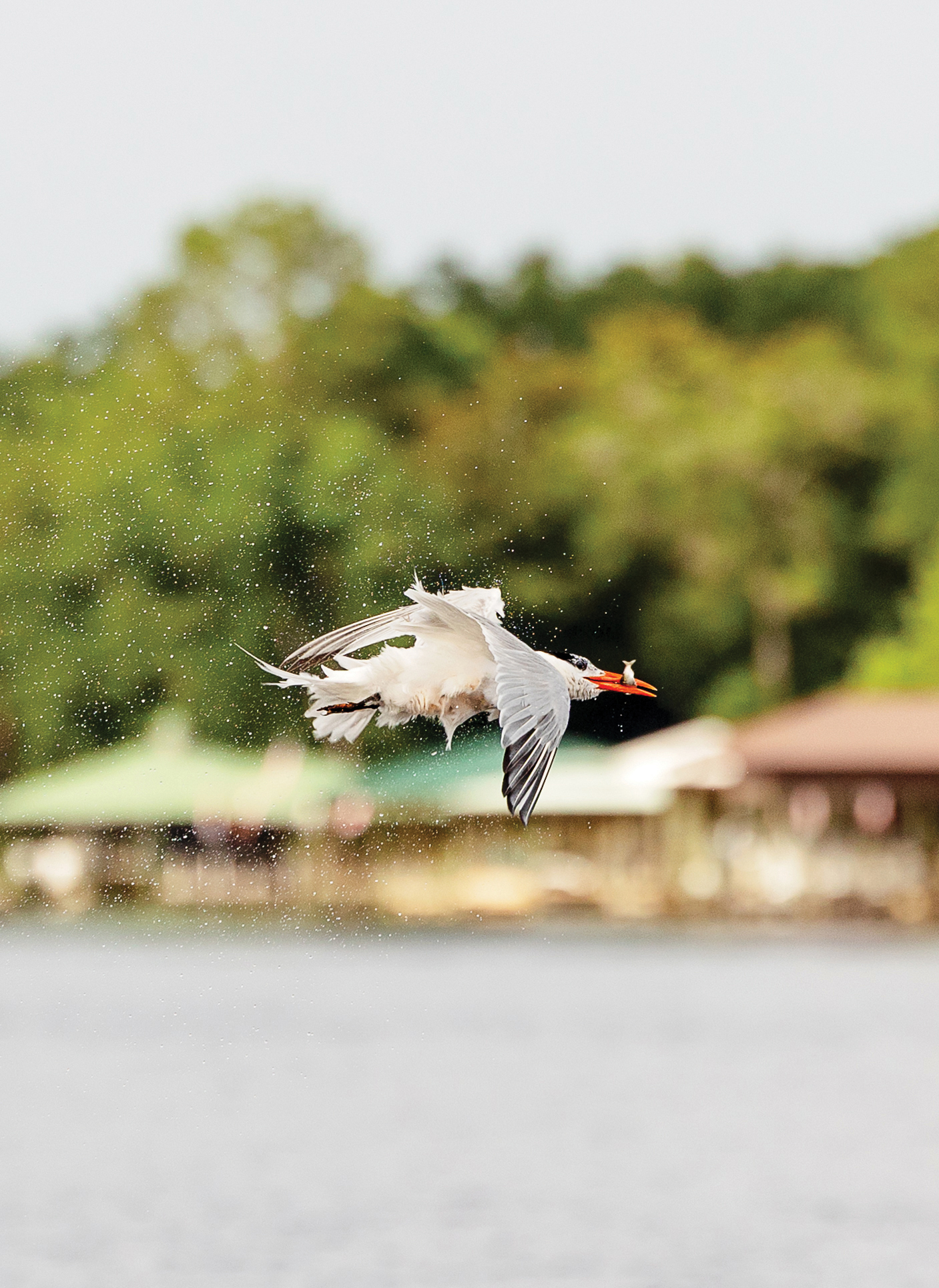
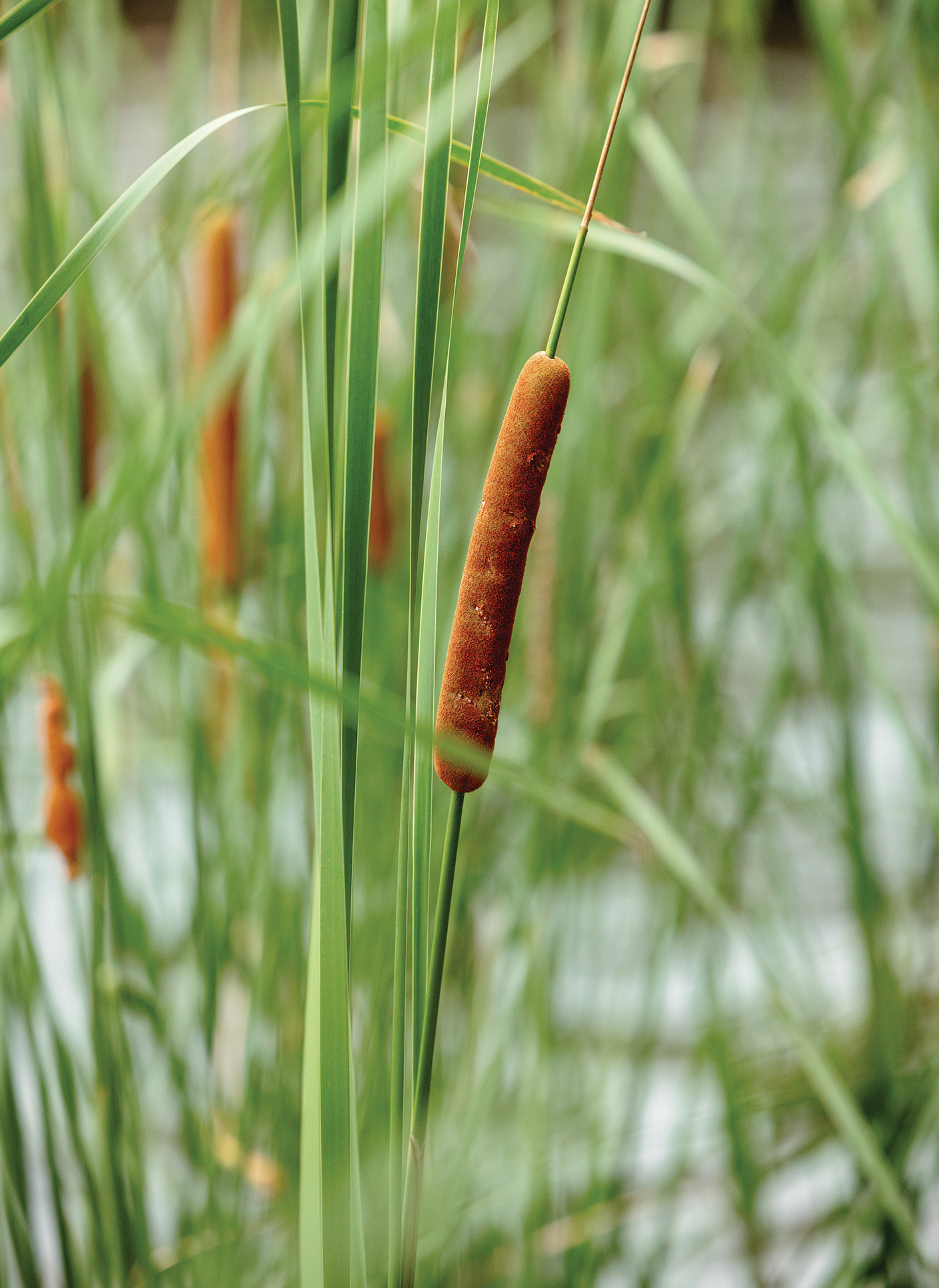
HISTORY
Tributary
The history of Fowl River before the arrival of man is a secret kept by nature, but what we know of it begins with brothers and French explorers Jean-Baptiste Le Moyne de Bienville and Pierre Le Moyne d’Iberville. They arrived on the shores of Mobile Bay in the late 1690s and founded a settlement they named Belle Fontaine as a tribute to the beautiful fountain at its center. The two summoned French colonists from Louisiana to settle the region and construct a deep-water port on Dauphin Island. The transplants, who were as clever and imaginative with names as their forebearers, honored the waterfowl that dominated the wetlands by naming the main river “Riviere aux Poules,” or Fowl River.
The shipbuilding industry quickly took hold in the region, the oldest shipyard being established in the 1850s on Mon Luis Island at the at the mouth of the pass between Mobile Bay and Fowl River. Locals benefitted from the growing trade at the cost of the land. Workers harvested ancient cypresses from the marshes for materials, impacting the diversity of the hardwood wetlands and disturbing the surrounding habitats in the process. Manufacturing accelerated as Confederate Navy boats were constructed to penetrate the Union blockade in Mobile Bay and sustained until the mid-1900s. The Mon Luis Island shipyard shuttered in 1954, but the industry persists through smaller boatyards that dot the riverbank.
Though the Mon Luis shipyard brought some marine traffic to the mouth of Fowl River, less of it made it into the river proper. It wasn’t spared human encroachment due to lack of vision and ambition. Terrain, legislation and practicality saved it. In 1908, the Army Corps of Engineers surveyed Fowl River as a possible canal for the intercoastal waterway. It was about as poor a proposal as it could have been. Its depth and winding shape made dredging expensive, tides posed constant upkeep and the area lacked commercial demand. The Secretary of War and Board of Engineers for Rivers and Harbors determined that almost any other passage would be more suitable for their needs, and they abandoned plans for any development of the eastern side of Fowl River. As one resident puts it, “And thank God they did.”
Much of the river is as it always has been, and much of it has changed. A cut was dredged in West Fowl River in the 1930s to make it more traversable for larger watercrafts. Tides, traffic and rising sea levels have eroded the banks and marshes, exposing tangles of swamp magnolia roots and razing grass beds. Some individuals, recognizing the urgency to respond to a rapidly changing environment, have launched an aggressive campaign to save what remains.
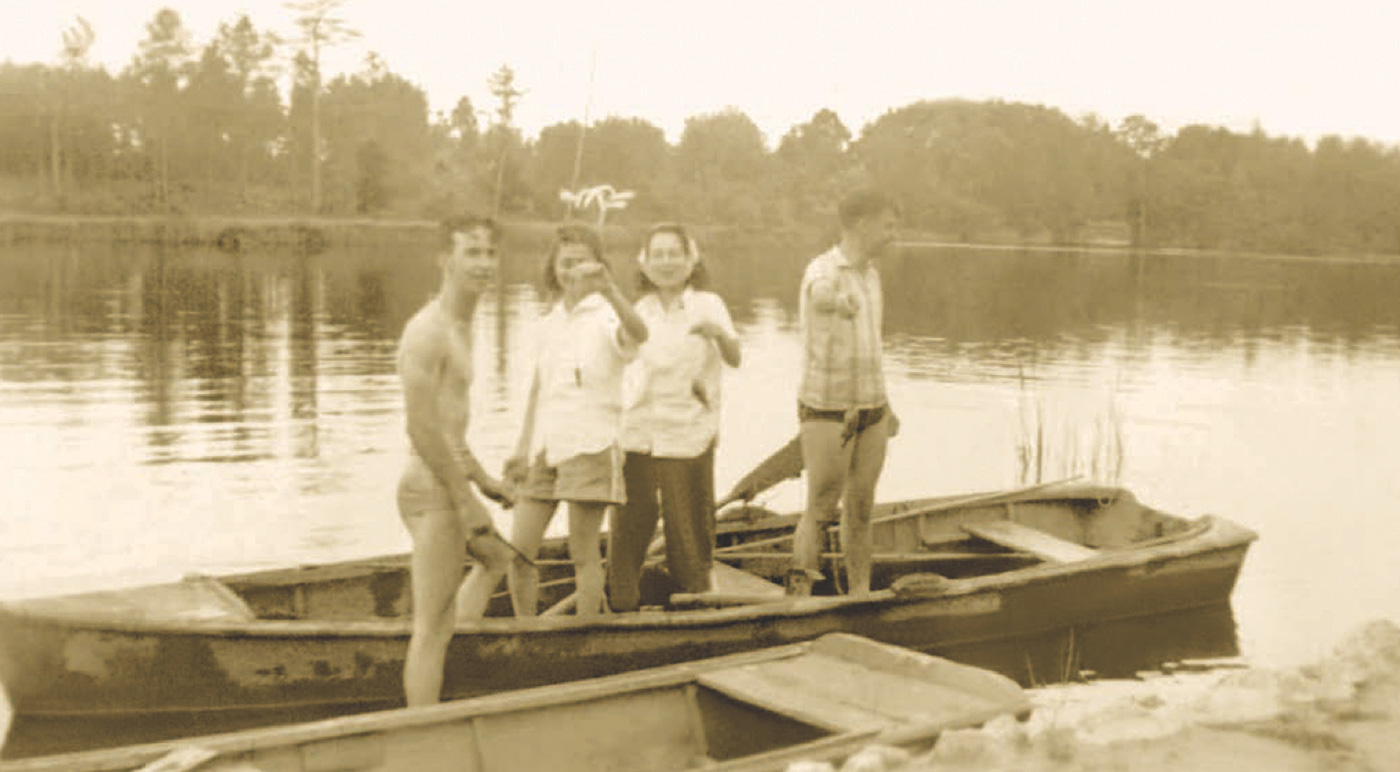
CONSERVATION
Marshes
Mrs. and Mr. Walter Bellingrath built their fish camp-turned-estate on Fowl River for good reason. The home overlooks a yawning wetland framed by hardwoods where blue herons pluck fish in the shallows and brown pelicans nearly brush the water in flight — a view that’s drawn many more to the river in the last century. Most of the watershed remains wild, with 21% being classified as urban and residential areas and 15% being used for agriculture. Projections for coming years indicate tremendous residential and urban growth, bringing with it the threat of increased industry, infrastructure, traffic, erosion and pollution. Conservationists and watershed citizens will hear nothing of it.
Fowl River locals have learned their place in nature, and they expect new developments to do the same. In May 2025, multiple environmental groups successfully pushed back against a proposed landfill, prompting the company to withdraw its application. Those same advocates have also opposed harmful sewage expansions, promoted low-impact lawn care, partnered with farmers to reduce runoff and protected marshes that naturally filter pollutants from growing construction sites. The river sustains the lives that depend on it, and catastrophes in the water would have devastating consequences on the world that surrounds it.

After the Deepwater Horizon Oil Spill, Fowl River conservationists and residents dumped several bags of oranges at the mouth of the channel to document tidal flows and determine how to prevent crude oil from infiltrating the wetlands.
Pollutants aren’t the only threats to the river. Erosion has severely impacted the health of the shoreline. The shrinking wetlands and marsh spits filter and recycle groundwater, provide feeding and breeding habitats for wildlife and protect the shores from essential nutrient loss. Some say boat traffic is the culprit, others blame intrusive saltwater tides and climate change. Regardless of the instigator, the problem is a grave one that has necessitated human intervention.
“Several years ago, I just got in the boat as usual and went up the river. I noticed all of the sudden that all these islands and spits and beautiful marshes were a fraction of what they used to be. It was like we had some nuclear disaster. Something’s happened,” says Alabama Coastal Foundation Board Officer Sam St. John. “I got some scientists to come down and walk around with me, and they were scratching their heads trying to figure out what was going on. I went out and documented everything I could by aircraft, and the best thing I found was a big piece of marsh that was nothing but roots where you could see how much soil had been lost.”
The Mobile Bay National Estuary Program, in partnership with the National Fish and Wildlife Foundation, the Alabama Coastal Foundation, the State of Alabama, the Dauphin Island Sea Lab, the Army Corps of Engineers and invested Fowl River locals conducted studies of the area that proved the pressing ecological issues and developed a restoration program for the compromised spits and wetlands.

Though they belong to the same water system, the eastern and western portions of fowl river each have their own watershed management plans due to the diversity of their ecological profiles.
The Fowl River Watershed Management Plan has been nearly a decade in the making. “We’ve been working on this project for eight years, and we have at least five or six more years in it,” says Mobile Bay National Estuary Program Deputy Director Jason Kudulis. “You’re talking about a decade-long process of studying, engineering, design, construction and monitoring. Something of this scale is very complex. It’s a large portion of someone’s career, so it’s got to be something you care about.”
Implementation of the blueprint began in 2024. Thin layers of sediment from Mobile River were layered in phases on each spit to replenish the eroded deposits and fortify the marshes for future impacts. The shorelines needed a different type of protection. Narrow strips of riprap were installed in strategic, particularly vulnerable areas, and timber wave screens were used around grass beds to reduce destructive wakes and ameliorate wildlife habitats. The watershed has healed in four seasons. New grasses on the marshes hide blue herons’ wings, speckled trout shelter behind wooden blinds and pelicans nest safely beneath sturdy cypresses and magnolias.

LIFESTYLE & RECREATION
Waterways
Across ages, across worlds, people have found joy in the water. Part of living on a river is delighting in it — making use of it beyond its utility. Estuarine life and play today is a different shade of what has always been, but most things remain unaffected by time. Some boat, some swim and some cast fishing lines off the pier and watch waves go by. Being on Fowl River kindles uncomplicated, nostalgic contentment that spans generations and heritages. It’s a rare easiness that lasts there.
Boats get used about as much as cars in the watershed — maybe even more. A ride across the river to someone else’s house is often shorter and more pleasant than the drive, but going by boat doesn’t mean that the trip will be brief. A quick jaunt becomes longer when neighbors are on their piers. It’s the unspoken rule that you have to stop to speak, and it’s another that visitors are given a drink. Deep-rooted residents Susu and Ollie Stuardi keep a mesh bag of huggers hanging on a pole. “We have a refrigerator out here too,” says Susu, pointing across her wharf. “You might be out on the boat for three hours just stopping to talk to people. It’s nice having something right there if anybody needs it.”
People still ride for fun as they always have. Small bass boats launch from the site of the old Jenkins Memory Store, a convenience store best remembered as the place where many young locals bought their first beers. Bigger, faster boats throw children on tubes and wakeboards in long arcs. It’s only a little different than it used to be.
“Boats weren’t as powerful as they are today, and there aren’t as many skiers, but we did do some of the same things,” says Ollie about the evolution of Fowl River recreation. “We would make our own skis and this thing we called a disc, which is just a piece of plywood you rode around on. I’d say the biggest change is that wakeboarding and tubing are more popular than skiing. We did tubing too, but ours was a real, black rubber inner tube, and you’d better have a shirt on or else you’d get rubber burns. You didn’t have to do it but once or twice — you’d learn really quick that you had to have a shirt on.”

There have been many Fowl River Civic Clubs over the years, including a ladies’ fitness group called the Fowl RIver Olympic team, who met at Tatum’s restaurant for what they called “Tea and Sympathy” after exercising.
Play can be slower and quieter too. The gentle dawn and evening waters give something entirely different to the people determined enough to enjoy them. After the sun sets, dark silhouettes underlit by dock lights cast lines into the water at the edge of the glowing halo. Kayaks and canoes launch just before sunrise. Sam St. John takes a paddleboard up the river into the headwaters where motorboats can’t reach. “It’s so wild up there. I have to break off limbs and fight off spiders to get through. Nobody really uses it,” says St. John. “People might be scared to go up there, I guess, but the water is crystal clear. You can see ten feet deep, and it’s just incredible.”
Every generation brings its own pace to the river. The youngest ones prune their fingers and rouge their cheeks staying in the water all day until they are called to supper. Grandparents lean back in Adirondack chairs with a drink and take in breezes and memories in the shade. Parents are somewhere in between, playing lifeguard and judging cannonball contests while trying to sneak in a dip in the water and some rest. It’s a scene many families have watched play out over decades.
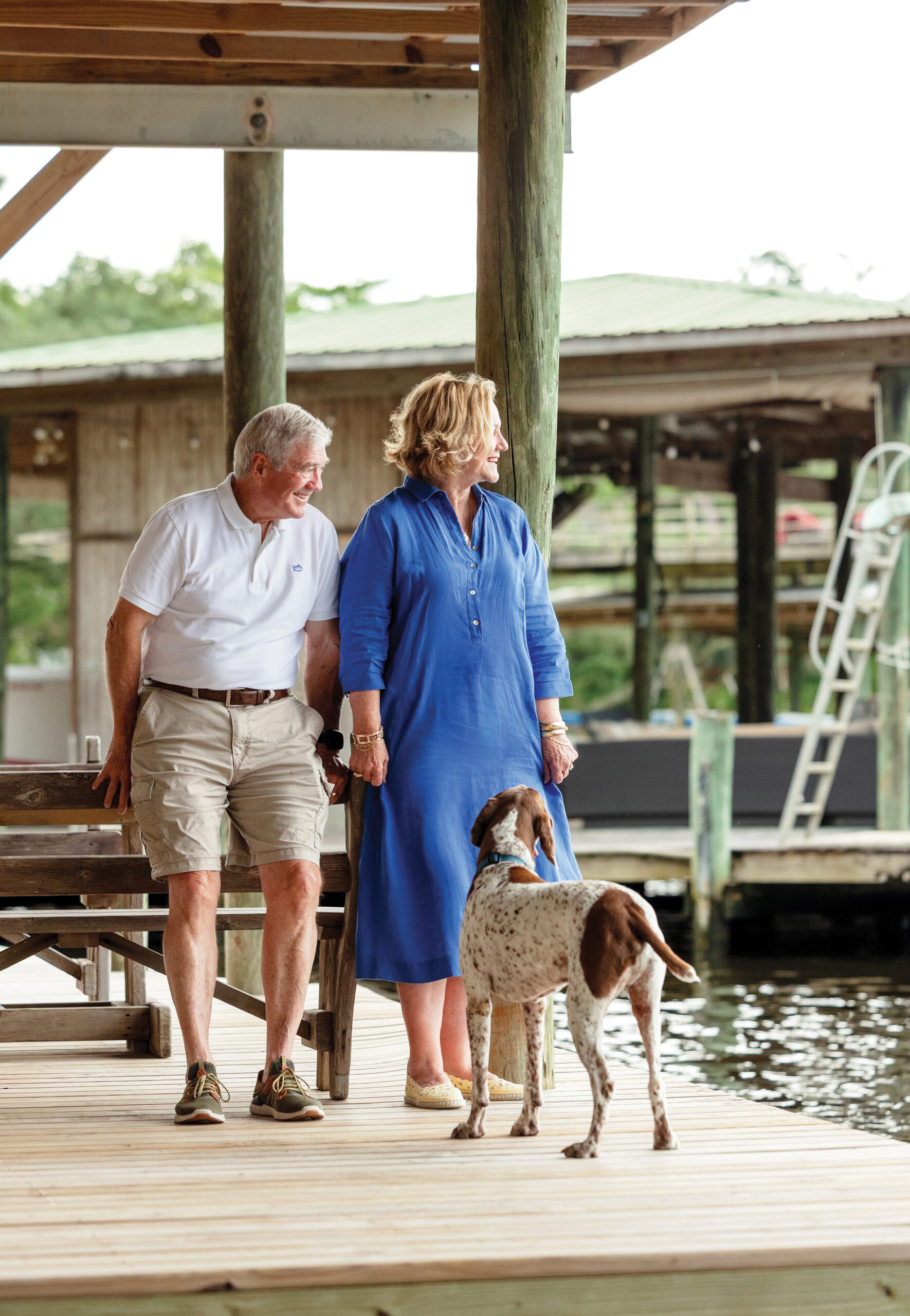
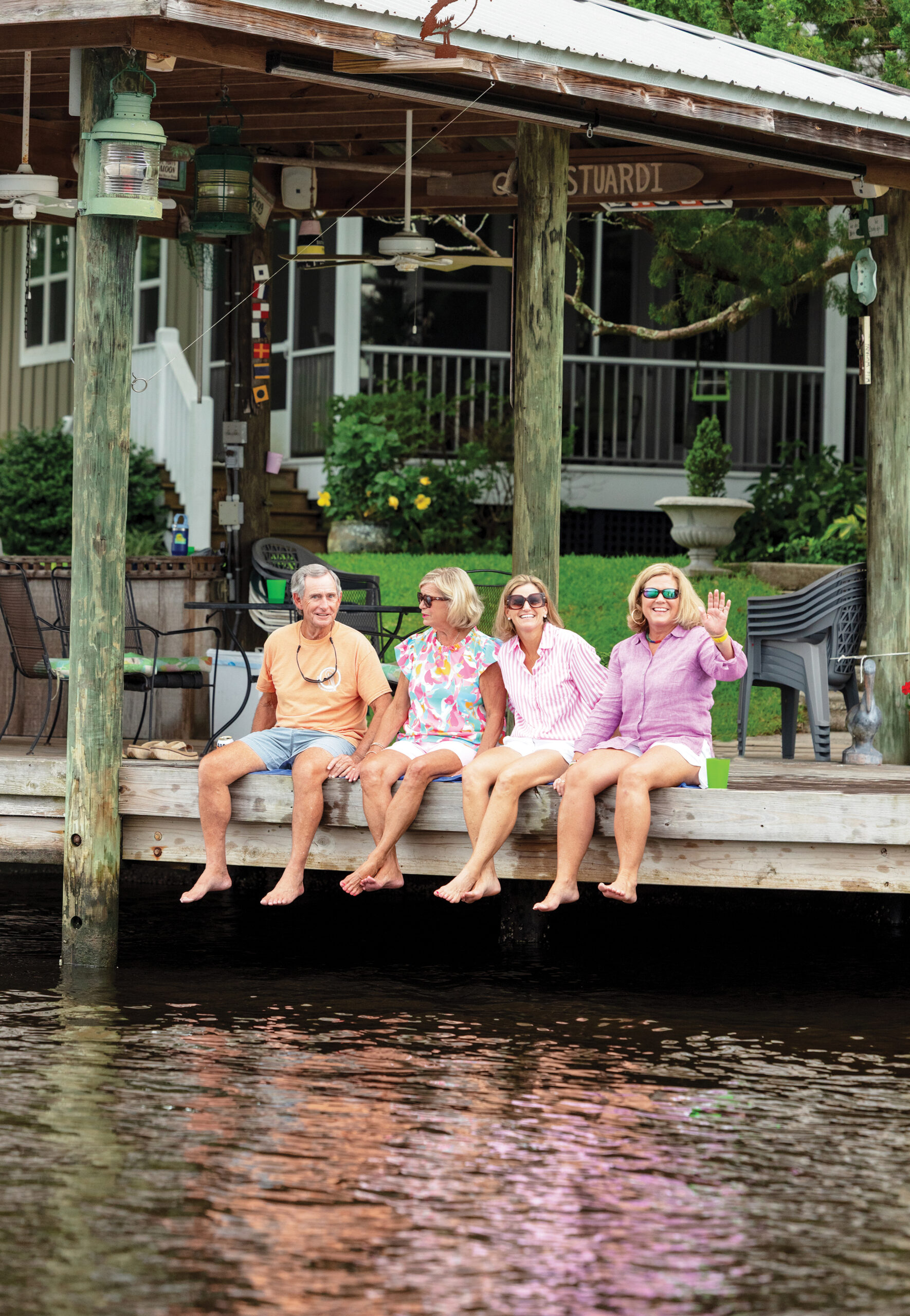
The Stuardis, during one season or another, have seated their lives on the river. “My husband’s family has had property on the river since the 1920s. We’d always come down to his parents’ house every Sunday, and the kids grew up coming down here, and it was so much fun, fun, fun — this is bringing back so many happy memories,” Susu recalls with a wistful smile.
“We bought our property in ’97 for weekend getaways. We weren’t even looking for a second home at the time. We sold our house in Mobile to live down here year-round. It was just a little fish camp with a screen porch, two little bedrooms, no closets. That’s what people had on Fowl River. Well, we lived in there for about 12 years and thought we’d eventually renovate it, but it was just too small. We tore it down and built a cottage on the same place. Several of our relatives are down here too — my brother, his sister, my nieces, my nephew. Now our kids keep coming down to our house and the tradition of being here with our family lives on.”
Like the Stuardis, generations of Mayhalls have grown up on Fowl River. “My grandfather bought a property and lived with my grandmother in the boathouse, and there was a cottage where different family members would stay, which is now owned by the 25 grandchildren,” says Ray Mayhall. “The river has been a part of our life. My wife and I have been married for 55 years, and when our children came, it became a part of their lives. We lived in North Carolina and Florida — different places away from here for over 40 years — but they never thought of those places as home. This was home for them.”
“When people come down here, they’re so thankful. But I tell them that’s the exact reason we built it,” adds Jacque Mayhall. “I’ll tell all the kids to bring their friends down. People will sit around our big table that I got from my momma and play games. The kids will stay in the river all day until late afternoon and come up to the pool or squish in the hot tub. I bet they have solved the problems of the world talking in that hot tub. I just want everyone to come down here and eat and relax. You know, when I started dating my husband in high school, I knew this was his heaven on Earth. So, if you dated Ray Mayhall, you had to love coming to Fowl River. It wasn’t hard to do.”
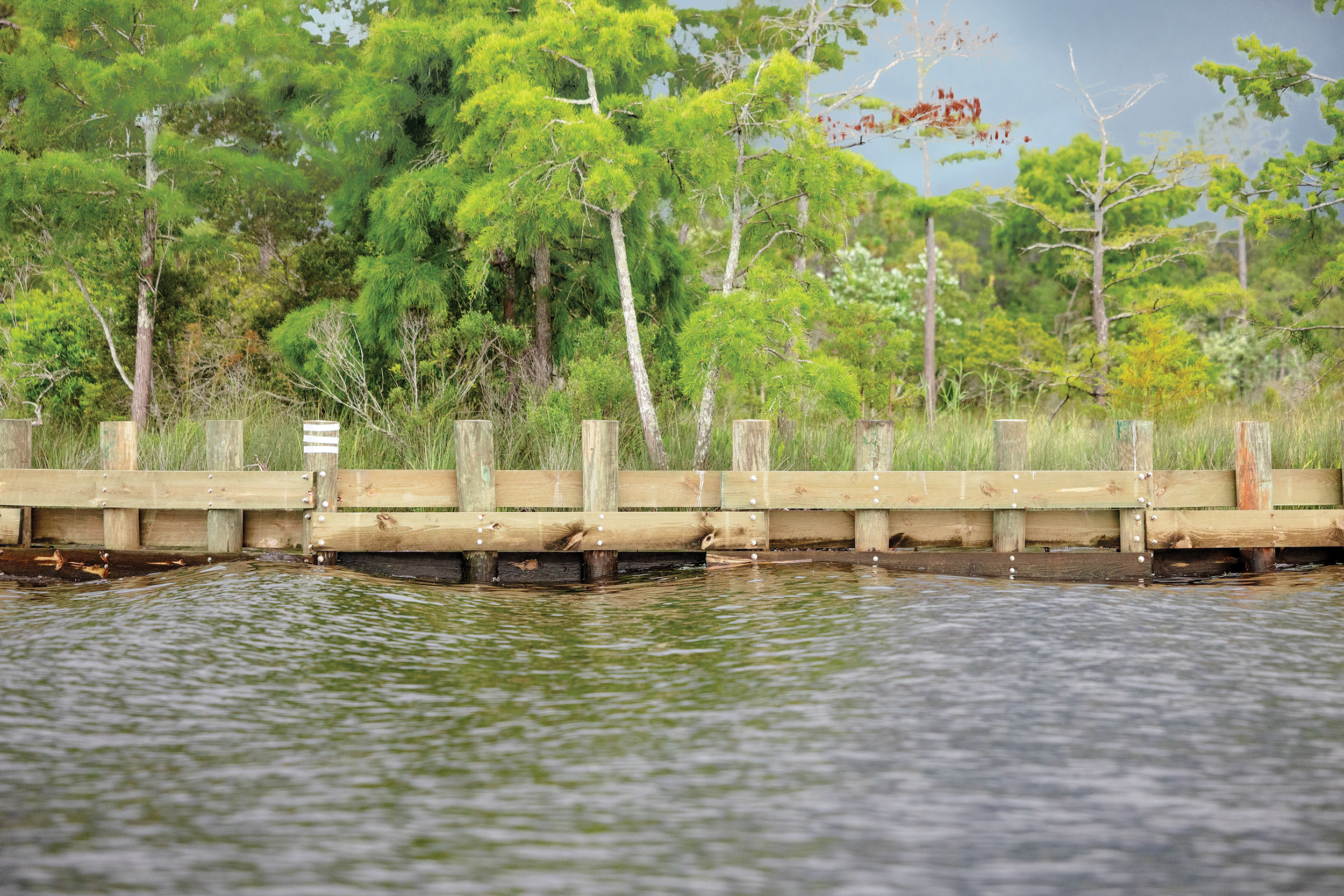
PERSPECTIVE
Delta
To live on Fowl River is to be a part of something greater and more enduring than the self. It existed before names and maps and rights of possession. Its wildness doesn’t bend to will, carving at the land and tending to its tenants at its own discretion. And yet, for its power and self-governance, its future depends on hands willing to protect what time and formidability cannot preserve. Fowl River gives more than it takes in bounty, in traditions, in memories and in joy. All it asks in return is that we tend it diligently, knowing we are only a chapter in its story.





